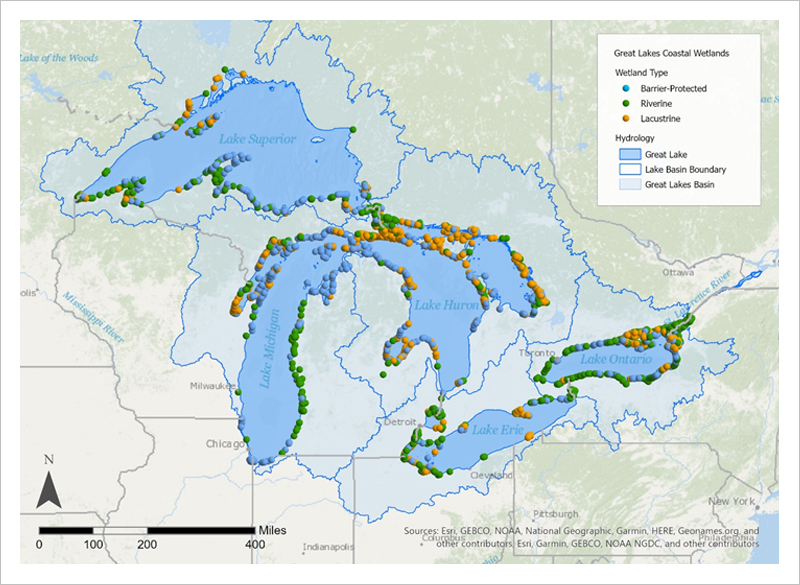How the Great Lakes Coastal Wetlands are Monitored
The Coastal Wetland Monitoring Program (CWMP) was established to monitor and report on the health of coastal wetlands in each of the five Great Lakes. Monitoring all coastal wetlands is logistically impractical and cost prohibitive, so the CWMP only monitors wetlands that are greater than 4 hectares (about 10 acres) in area and have a surface water connection to one of the Great Lakes or their connecting rivers. A total of 1,014 coastal wetlands meet these criteria and are scheduled to be sampled at least once every five years under a rotating schedule where approximately 200 wetlands are sampled each year.
Field work for the Great Lakes CWMP began in 2011. From 2011-2018, more than 1,000 coastal wetlands were visited (Figure 1), resulting in the assessment of over 400,000 acres of coastal wetland habitat. Funding for the program is provided through the Great Lakes Restoration Initiative (GLRI).

According to the CWMP sampling design, field crews collect environmental data to assess water quality and the condition of amphibian, bird, fish, macroinvertebrate and vegetation communities. Field crews also document existing shoreline land use, nearshore land cover, habitats and visible disturbances. Repeated monitoring of coastal wetlands over time allows for trends in coastal wetland health to be assessed. Annual data from the CWMP provide a long-term record of wetland status to support State of the Great Lakes reporting of coastal wetland health. In addition, resource managers and other decision-makers use CWMP data to decide how to best prioritize coastal wetland management actions and determine the need for future coastal wetland restoration, enhancement and protection activities.
Coastal Wetland Data and Indicators of Wetland Health
The CWMP monitors the health of Great Lakes coastal wetlands by measuring a variety of physical and chemical water quality parameters and collecting biological community data for plants and animals. An overview of data collected and indicators used to evaluate wetland health are described below. Detailed information about the CWMP sampling design, protocols and indicator calculations can be found at Coastal Wetland Monitoring Program (CWMP) Sampling Protocols. [1,2]
Water Quality
A variety of physical and chemical attributes of coastal wetlands are measured to assess water quality and wetland disturbance. These data are combined with land use/cover information in statistical procedures to calculate a disturbance-gradient score for each coastal wetland.
Physical and chemical attributes measured at each wetland include:
- Temperature (ºC)
- pH
- Dissolved Oxygen (% and mg/L)
- Transparency (cm)
- Oxidation-Reduction Potential (mV) of water
- Water Color (Platinum cobalt scale)
- Chlorophyll-a (µg/L)
- Phaeophytin (µg/L)
- Specific Conductance (µS/cm)
- Phenolphthalein Alkalinity (µg/L)
- Total Alkalinity (µg/L)
- Chloride (mg/L)
- Ammonium Nitrogen (mg/L)
- Total Dissolved Solids (µS/cm)
- Turbidity (NTU)
- Nitrate + Nitrite Nitrogen (mg/L)
- Total Nitrogen (mg/L)
- Soluble Reactive Phosphorus (mg/L)
- Total Phosphorus (mg/L)
Assessing Biological Community Health in Coastal Wetlands
The CWMP collects information about the number of plant and animal species present at monitored wetlands and the relative abundance of each species to assess biological community health in coastal wetlands. Different plant and animal species have varying levels of tolerance to disturbance. Some species can tolerate highly disturbed or polluted wetlands while others require pristine conditions. CWMP data are used to calculate Index of Biotic Integrity (IBI) scores representing the health of plant, fish, and macroinvertebrate communities and Index of Ecological Condition (IEC) scores representing the health of bird and amphibian (frog and toad) communities. IBI and IEC scores combine the number and abundance of each species or group of species present with each species’ level of tolerance to disturbance, producing a scaled measure of the quality or health of the community. By considering the health of plant and animal communities together, a more holistic assessment of wetland health can be made. See: Great Lakes CWMP Results and Major Findings.
References
[1] Uzarski, D.G., Brady, V.J., Cooper, M.J. 2019. Coastal Wetland Monitoring: Continued Implementation by the GLCWC. Quality Assurance Project Plan (QAPP) and SOPs. Revision 1 - April 2019. 95 pp. Cooperative Agreement Contract: EPAGLNPO‐00E01567.
[2] Uzarski, D.G., Brady, V.J., Cooper, M.J., Wilcox, D.A., Albert, D.A., Axler, R.P., Bostwick, P., Brown, T.N., Ciborowski, J.H., Danz, N.P., Gathman, J.P., Gehring, T.M., Grabas, G.P., Garwood, A., Howe, R.W., Johnson, L.B., Lamberti, G.A., Moerke, A.H., Murry, B.A., Niemi\, G.J., Norment, C.J., Ruetz, C.R., Steinman, A.D., Tozer, D.C., Wheeler, R., O’Donnell, T.K., Schneider, J.P. 2017. Standardized measures of coastal wetland condition: implementation at a Laurentian Great Lakes basin-wide scale. Wetlands. 37. 15-32.
Back to: About the Great Lakes Coastal Wetland Monitoring Program
